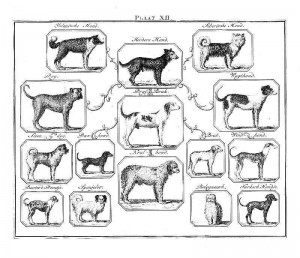By Lisa Smith, W&M Contributor
Beagles, that adorable and humble breed of hunting dog, were at the centre of a debate about the meaning of civilisation and nature in the eighteenth century. Long before Charles Darwin, scientists (or natural philosophers as they were called at the time) wanted to understand the process of breeding, as well as the differences between people of different cultures.
Dogs, with their wide variety of breeds and accessibility, provided a particularly fruitful ground of investigation. The work of French natural philosopher Georges-Louis Leclerc, comte de Buffon was particularly controversial and well-known—so much so, that it made its way into the Encyclopaedia Britannica, 2nd vol. (Edinburgh, 1771) under the entry for ‘canis’.

Dog Species Chart, from Buffon’s Natural History. Image Credit: http://vintageprintable.com/wordpress.
The Encyclopaedia summarised Buffon’s arguments for a wider audience. In his thirty-six volume Natural History (1749-1789), Buffon had suggested that all quadrupeds were descended from a small number of distinct types. Differences in climate, treatment or diet could result in variations, which Buffon saw in terms of improvement or degeneration. Buffon hypothesised that the first dog (the Adam of the canine world) would have been something like a shepherd’s dog, but “when brought up in a country fully civilised, as Britain or France, loses his savage air”. The dog also changed appearance. Rather than having thick and long hair or pointed ears, the dog became a bull-dog, mastiff or hound. These changes were not universal, however. For example, the bull-dog’s ears remained partly straight “and resemble in their manners and sanguine disposition the dug [breast] from which they derive their origin”.
The beagle looked even less like the original shepherd’s dog. “Its ears are long and entirely pendent; the softness, the tractability, the timidity of this dog”, proclaimed the Encyclopaedia, “Buffon considers as many proofs of its degeneracy, or rather of that perfection which it acquires by culture, and living among a civilised people”.
Not everyone agreed with Buffon’s assertion that the changes occurred because of civilisation. James Anderson, in one of his monthly issues of Recreation in agriculture, natural-history, arts and miscellaneous literature (London, 1799-1802) dismissed Buffon as a bit daft for thinking that all varieties of every species might descend from common stock.
From a post-Darwinian perspective, we can understand the sense in Buffon’s argument, but Anderson had legitimate grounds for complaint: that Buffon had failed to provide good evidence. Indeed, Anderson pointed out that dogs were not a particularly good example and objected, specifically, to Buffon’s claims that climate and geographic region could transform an animal. A British dog might, for example, accompany his owner to the other side of the world, but would remain the same. Anderson was adamant that a bull-dog in England showed the same obstinacy in ancient Rome as today and that a greyhound’s litter in Norway could not suddenly become bull mastiffs! A dog possessed the same qualities at birth that it would possess throughout life, no matter its location. While a dog’s temperament might change—becoming leaner, fatter, healthier or sicker—it would never become another breed.
Unless… a female mated with a male of a different breed, resulting in an “impure race” that had the qualities of both parents. This, then, was how Anderson explained breed variety. Different breeds were in fact artificial creations. There was no such thing as a natural dog. Although Buffon had thought that wild and domestic dogs were so distinct that they were unable to reproduce, surgeon John Hunter demonstrated through a series of experiments that such matings frequently resulted in offspring. According to Anderson, the beagle only differed from a bull mastiff because of selective breeding on the part of humans rather than its climate or food.
The debate itself reflected several strands of Enlightenment thought. Throughout the eighteenth century, scholars set up dichotomies between civilisation and nature. Civilisation was alternately good (allowing reason and order to flourish) and bad (resulting in artifice, corruption and inferior stock). In an increasingly imperial age, the implications went beyond how people saw their pets. Such ideas reflected the way that the British and French encountered the natural world and other cultures across the globe. Whether one thought civilisation was good or bad, however, one thing remained the same: the world could only be understood in terms of hierarchies, classifications and dichotomies.
Lisa Smith is an Associate Professor of History at the University of Saskatchewan. She writes on gender, family, and health care in England and France (ca. 1600-1800), as well as teaches a course on “Defining Boundaries: Natural and Supernatural Worlds in Early Modern Europe”. She also blogs weekly on history of medicine and science at her Sloane Letters Blog and edits The Recipes Project. Follow her on Twitter, where she tweets as @historybeagle.

